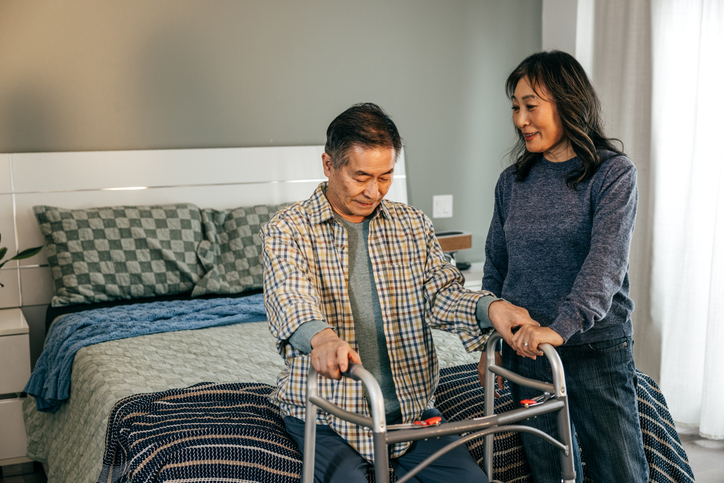Category: Health
How to Choose a Medical Power of Attorney and Stay Prepared
November 6, 2025

A few years ago, a close friend of mine went through something that completely changed how I look at “being prepared.” Her dad had a stroke while working in the garden. One minute he was watering plants, the next, he was in the hospital, unable to speak. The doctors were asking who could make medical decisions for him, but no one had an answer. Everyone froze.
It was heartbreaking to watch. Her mom was in shock, her siblings were arguing, and everyone was scared. Nobody knew what he would have wanted.
That day taught me something that I’ll never forget. Planning ahead isn’t just about being responsible. It’s an act of love. And that’s exactly what a Medical Power of Attorney is all about.
What a Medical Power of Attorney Really Means
A Medical Power of Attorney (MPOA) sounds like a complicated legal thing, but it’s actually simple. It’s a document that lets you choose someone you trust to make healthcare decisions if you can’t.
That person, your agent, doesn’t suddenly take over your life. They only step in if you can’t speak for yourself. Their role is to protect your wishes and make sure what you want actually happens.
It’s one of those things we tend to put off, but once it’s done, it brings a quiet kind of comfort. You know things will be okay, even if you can’t explain what you want in the moment.
Why It Matters
If you don’t have a Medical Power of Attorney, hospitals usually turn to whoever’s nearby or follow state laws about next of kin. That can work, but it can also cause a lot of tension. In stressful moments, people don’t always think clearly. They guess, they argue, they panic.
Having an MPOA avoids all that. It gives doctors one clear person to speak with and gives your family direction when things feel uncertain. It’s a simple form, but it can prevent a lot of heartache later.
How to Choose the Right Person
Choosing your agent isn’t about who’s closest to you. It’s about who knows you best. The person you trust most doesn’t have to be family. It could be a friend, a sibling, or someone who simply understands you.
Here’s what to think about:
- Who stays calm under pressure?
- Who knows how you feel about medical care and quality of life?
- Who will listen to doctors carefully and ask good questions?
- Who will do what you want, even if others disagree?
Once you decide, talk to them. It doesn’t need to be formal or serious. Maybe just bring it up during a car ride or while cooking dinner. Tell them how you feel about certain treatments or what kind of care you’d want. These honest conversations matter so much more than any form.
Keeping Your Documents in Order
Once your form is signed, keep it somewhere easy to find. In an emergency, no one wants to dig through stacks of paper.
Here’s what to keep together:
- Your MPOA form (signed and dated).
- A Living Will or Advance Directive describing your medical preferences.
- A HIPAA release form so your agent can speak with doctors.
- Health insurance cards and policy info.
- Emergency contacts for family and doctors.
- Photo IDs for you and your agent.
I like to keep mine in a labeled folder at home and another copy saved online. It’s one of those “just in case” things that saves everyone stress later.
Why Digital Storage Helps
Paper gets lost. It gets packed in a box or tossed by accident. That’s why having a digital copy is smart.
A secure site like InsureYouKnow.org makes it easy to upload and store important documents safely. You can label them, share access with your agent, and know that if you ever need them, they’re right there. It’s simple, private, and safe.
It’s not about being tech savvy, it’s about being practical.
Keep It Updated
Life changes. People move, relationships shift, new doctors come into your life. Once a year, take five or ten minutes to check that your MPOA and other forms are still up to date.
It doesn’t take long, but it gives you peace of mind that everything’s current.
A Final Thought
Setting up a Medical Power of Attorney isn’t about expecting bad things to happen. It’s about kindness, for yourself and the people who love you.
Once it’s done, you can stop worrying. You’ll know that, no matter what happens, your family won’t be left guessing. They’ll already know because you cared enough to prepare.
It’s not just a document. It’s peace of mind, and maybe one of the most loving things you can do.
Love in the Final Chapter: Caring for a Loved One in Home Hospice
October 15, 2025

When it comes to end-of-life care, 71% of Americans believe the goal should be to help people die without pain, discomfort, and stress. The focus of hospice care is on quality of life and symptom management, and it is designed to provide comfort to individuals with a life expectancy of six months or less.
A team of medical professionals addresses the patient’s physical, psychological, and spiritual needs on a case-by-case basis, ensuring that every patient receives a care plan tailored to their specific needs. Care is most often delivered in the patient’s home, and the hospice team can support caregivers during this process.
Quality is Key
Hospice is end-of-life care, but that doesn’t mean someone receiving care will pass right away. While doctors recommend hospice when a patient only has six months or less to live and is no longer responding to curative treatments, many patients live longer. In such cases, what matters still is a patient’s quality of life, not quantity.
“Each person’s journey at the end of life is different,” says Jessica Kelly, a licensed hospice nurse in New York. “We tailor our care to meet those unique needs, whether that’s managing pain, supporting emotional well-being, or helping families share meaningful moments together.”
Home Care Takes a Toll
While it is nearly everyone’s preference to pass away in the comfort of their own home, the task of caregiving can be more than loved ones expect. “I do think that when patients are at home, they are in a peaceful environment,” says Parul Goyal, a palliative care physician. “It is comfortable for them. But it may not be comfortable for family members watching them take their last breath.”
The burden put on loved ones, especially spouses, can cause caregiver syndrome, which is characterized by the stress and burnout that comes from providing constant care to someone who is chronically or terminally ill.
“Our long-term-care system in this country is really using families, unpaid family members,” says Katherine Ornstein, a professor of geriatrics and palliative medicine at Mount Sinai. “What we really need to do is to broaden the support that individuals and families can have as they’re caring for individuals throughout the course of serious illness.”
Self-Care for Caregivers
Providing care to a hospice patient can be both rewarding and difficult. Social psychology researchers Richard Schulz and Joan Monin found that caregivers suffer when they witness their loved one’s suffering without feeling like they can remedy it. It becomes important not just to care for the patient but for caregivers to care for themselves as well.
One way to start accepting a terminal diagnosis is to begin getting a loved one’s affairs in order. It can be helpful to collect necessary documents and passwords and to begin sorting through possessions. Staying busy during the care process can help manage emotions as they arise.
Handling Grief
It’s easy to get paperwork and belongings in order. It’s not as easy to manage your grief. The loss of a loved one is among life‘s most significant stressors. Grief can affect every aspect of your health. While everyone’s experience is different, it is common to feel intense emotions during a loved one’s illness and after losing them.
Here are ways caregivers can take care after loss:
- Express your emotions. Bottling them up will only intensify them.
- Don’t put yourself on a timeline. People move forward at their own pace. Trust that your pain will lessen over time.
- Take care of yourself as you grieve. Eat nourishing meals, stay hydrated, and sleep enough.
- When you’re ready, exercise. It can reduce stress, tension, and sadness.
- Hospice providers make grief support groups available to anyone who has lost a loved one in hospice care.
- The Hospice Foundation also offers a newsletter to help during bereavement.
When to Seek Help
Most people find a way to adjust to their loss, but it is a painful and uncomfortable process. About 10% to 15% of people who are grieving have a complicated reaction to their loss. Grief experts agree that if grief is unmanageable, meaning someone has not returned to their pre-loss level of functioning within six to 12 months, it may be time to seek the professional help of a grief counselor. Your hospice team can help you find the care you need.
Handling a loved one’s affairs is one way caregivers can manage their grief. With Insureyouknow.org, you may organize financial documents, property records, and other documentation of personal effects. Getting everything in order can bring you some peace of mind during emotionally challenging times.
A Simple Guide to Choosing a Medical Power of Attorney
September 15, 2025

Studies show that the treatment wishes of patients vary greatly from those of their family members, yet only a third of Americans have a medical power of attorney in place. With a medical power of attorney, you can legally designate an agent to handle your medical decisions should you become unable to speak for yourself. It also includes instructions on the kinds of medical treatment you wish to receive.
Even if you do not know your wishes, a medical POA ensures that the person you trust can make those decisions for you. “A medical power of attorney is a pretty powerful document,” says William Raftis, attorney for Student Legal Services at Texas Tech. “It grants a person to make medical decisions on behalf of another person in the case that they are unable to make such a decision for themselves.”
Without a Document
When you don’t have a medical power of attorney and you are unable to tell the doctor your preferences, the following people would be legally authorized to make your healthcare decisions:
- A court-appointed guardian or conservator
- Your spouse or domestic partner
- One of your adult children or siblings
- A close friend
- Your nearest living relative
It’s important to know that if you have a medical POA and get married, then that document is revoked. If you do not want your spouse to act as your agent, then you must have a new medical power of attorney written up.
Choosing an Agent
To designate someone as your agent, you must sign a legal medical power of attorney document that names an agent and the healthcare decisions you’d like them to make if you become unable to. Your agent can decide whether or not to admit or discharge you from a hospital or nursing home, which treatments you receive, and who has access to your medical records.
Many people mistakenly believe that designating an agent and signing a medical POA grants that person the authority to make all of your healthcare decisions. But a medical power of attorney is only necessary if you become unable to make your own decisions.
Every state has its own legal requirements for medical POAs, such as witnesses and notarization, but you may not even need a lawyer to draw up a medical POA. Many states provide free forms through government websites. If your state does not offer forms online, consider inquiring with healthcare providers and hospitals, as they may also have forms available.
Comfort is Key
The person you designate to be your agent should be somebody whom you trust. They should be over 18 years of age and should not be a doctor or healthcare professional. The person you choose should be someone who you know will carry out your wishes. You should discuss your wishes with them in advance and ensure that they will be comfortable making those decisions on your behalf.
If it makes you more comfortable, you may appoint two people to serve as co-agents or a successive agent in case the first agent becomes unable to do so. Keep in mind that it may create confusion when multiple agents are involved in the decision-making process. Healthcare professionals may only be able to reach one agent in the event of an emergency, or agents may disagree about how to carry out your wishes best.
Make Those Decisions Now
In addition to choosing your agent, your medical power of attorney should state your wishes.
The medical POA should state:
- Whether or not you want to use machines to be kept alive or receive feeding tubes
- Name a legal guardian, if needed
- Whether or not you want to donate any organs in the event of your passing, and what to do with your remains
If at some point, you change your mind about any of your directives or who you’d like to be your agent, then you should have a new medical power of attorney drawn up.
Medical POA Safekeeping
You should always inform your agent of any changes made to a medical POA and make sure they have the most up-to-date copy. Then store your document in a safe but easily accessible location. A medical power of attorney should be stored in both a physical safe place at home and a secure digital platform. Provide your attorney with a copy, as well as your healthcare providers and other trusted loved ones.
Why Documentation Matters
Emergencies come without warning. Without documentation in place, confusion over what’s best for you will add stress to an already difficult circumstance. Every adult should have a medical power of attorney in place, even adult children going off to college. “Students are 18 and they are now legally adults,” says Raftis. “It’s really just a way to help empower the students to make sound medical decisions.”
Acting early guarantees that you will have the necessary support during an emergency. This proactive approach enables families to focus on their loved one’s care rather than paperwork. “It’s a gift to your family to get these plans in place,” says Sally Hurme, an elder law attorney in Virginia. “Why create chaos, indecision, confusion, frustration, turmoil =—all of these may happen if you don’t have advance directives.”
Being clear about how you want to be cared for doesn’t just protect you; it also ensures that you receive the care you need. It prevents your loved ones from having to make painful decisions on your behalf under emotional circumstances. In this way, a medical power of attorney provides peace of mind for both the individual and their loved ones. With Insureyouknow.org, you can store all of your medical records and healthcare documentation in one simple-to-review place, giving you more time to focus on what matters.
Digital Pet Records: Organize and Store Pet Documents Securely
September 3, 2025

Pet emergencies rarely arrive at the right time. A dog limps after a jump. A cat suddenly won’t breathe easily. Owners grab at folders, glove compartments, even the folded vaccination slip that’s been stuck under a fridge magnet for months, only to realize the insurance info or medical history is still missing.
The vet keeps asking questions. What shots were given? What allergies are known? Too much time slips away.
That’s why keeping pet records, health notes, policy papers, and vet numbers saved in one secure digital spot makes such a difference. Instead of chaos, the details are ready in seconds. And that can mean faster decisions and better care when pets need it most.
Why Digital Pet Records Matter
In a real emergency, minutes feel heavy. A vet may ask about past shots or allergies, but the papers are often buried, tucked in a kitchen drawer under receipts or lost in an old email. With digital pet records, the answers are ready in seconds, and treatment doesn’t have to wait.
The same holds true when care is handed off. A sitter, a family member, even a boarding kennel can check pet medical files online instead of relying on rushed notes over the phone.
The truth is, organized records bring peace of mind. Storing pet papers safely in one place removes clutter and helps ensure steady care, whether at home, traveling, or in an emergency room late at night.
What to Include in Your Digital Pet Emergency Kit
When something goes wrong, the last thing anyone wants is to dig through drawers for missing papers. A simple digital kit avoids that headache.
The basics come first: vaccination records and health notes. Vets usually ask for them before doing anything else.
If the pet has coverage, add the insurance policy number and provider. It saves phone calls later. Keep proof of ownership too, like microchip info, adoption papers, or even a vet’s ID slip.
An emergency contact list matters just as much. The family vet, a backup clinic, a sitter, and one relative who can step in should all be easy to reach.
Then there are the little things. Care notes about food, medicine, or allergies may sound small, but they help anyone give consistent care. Storing these pet papers online in one safe place means less panic and faster help when every minute counts.
How to Securely Store Pet Documents Using InsureYouKnow
InsureYouKnow makes it simple to keep pet papers in order. Snap a photo of a vaccine slip or scan an insurance form, then upload it with a clear label like “Bella – Shots” or “Max – Insurance.” No more shuffling through drawers when the vet is waiting.
The files stay safe with encryption, so medical notes and policy numbers are private but easy to reach. Reminders can be set for shots or policy renewals, which means nothing gets overlooked.
Sharing is easy too. A sitter, boarding place, or vet can be given access to just the records they need, making care smoother and less stressful.
With everything in one place, digital pet records stay organized, secure, and ready when pets need it most.
Organizing and Managing Pet Info
Saving files is just the start. How they’re organized matters. Clear labels like “Vaccination,” “Insurance,” or “Ownership” make documents easy to find.
Adding details like the pet’s name, birthdate, or microchip number helps avoid mix-ups, especially with multiple pets.
Updates are important too. After checkups, insurance renewals, or when a new pet joins, taking a few minutes to update records keeps digital pet documents accurate and ready when needed.
Emergency Scenarios Where This Helps
Imagine the dog collapses during an evening walk. Heart racing, the family grabs the leash and heads to the vet. They don’t have to dig through drawers or emails. Digital pet records are ready on a phone. Shots, allergies, medications, all visible in seconds. The vet can start treatment right away, and stress levels drop for everyone.
Not all emergencies are medical. Moving suddenly, last-minute boarding, or traveling with a pet can turn chaotic fast. Having pet papers stored securely online means sitters, boarding staff, or vets can see what’s needed without endless calls or searching.
A few organized files can turn panic into calm. Pet documents online make sure pets get the care they need, wherever and whenever an emergency strikes.
Conclusion
Just like people, pets have important papers that need care. The vet, insurance info, and vaccination slips all matter. If you’re running around during an emergency, it’s easy to lose track. That crumpled slip under the couch or buried email suddenly matters more than ever.
The truth is, digital pet records make life simpler. Snap a photo, upload it, and label it clearly. Share it with your vet, a sitter, or a boarding facility when needed. It’s quick, secure, and saves time when every second counts.
Take a few minutes today to set up your pet’s digital profile with InsureYouKnow. It’s simple, it’s safe, and it gives peace of mind knowing your furry friend’s records are ready when they’re needed most.
The Mental Health Gap: What Parents Miss and Teens Need
September 1, 2025

Your teen says they’re fine. But they’ve stopped texting friends, spend more time in their room, and their grades are slipping. Could you spot the signs if they were struggling? Only 58% of U.S. teenagers feel they get the emotional support they need—yet 93% of parents believe they’re providing enough.
Findings like these show that parents may not always realize when their child is struggling. Young people today face different challenges than their parents and previous generations did. More than ever, parents must understand the unique pressures young people are struggling with today.
Challenges Faced by Teens
Nearly 10% of all U.S. kids aged 3 to 17 experience anxiety, while 5% live with depression. A few causes are listed below:
- Many young people are dealing with packed schedules, the pressure to succeed in academics, sports, and extracurriculars, and the uncertainty of what comes after graduation. The pressure to excel can lead to burnout.
- With in-person learning, the fear of school shootings can create a general sense of day-to-day unease.
- Students who remember the pandemic lockdown may have posttraumatic stress from virtual learning and social isolation.
- Social media has introduced young people to near-constant comparison, leading to low self-esteem. Body dissatisfaction is leading to a rise in eating disorders.
- Concerns over climate change can also lead to feelings of hopelessness.
Warning Signs
As a parent, you have a good sense of what your child’s “normal” looks like. In addition to the more striking symptoms, such as mood swings, angry outbursts, or being more tearful than usual, you may notice:
- Changes in eating habits, weight, sleep, or other routines
- Loss of interest in the things they once enjoyed or quitting activities
- Withdrawing from close friends or family
- Academic struggles that seem different or more intense, such as a refusal to complete assignments
- Becoming more visibly worried or expressing constant worry
- Any signs of substance abuse or evidence of self-harm, such as cuts, burns, or bruises
Just because your child exhibits any of these symptoms does not mean they are experiencing a mental health crisis. Biological changes, including hormonal shifts that all teenagers must go through, can affect their mood and school performance.
“It’s kind of hard because these things correlate with puberty,” says Theresa Nguyen, vice president of policy and programs at Mental Health America. “It gets hard for parents because this period of time is so muddy.”
Converse Differently
Checking in with your child is an ongoing process, not a one-time occurrence. Normalizing regular conversations with your child supports their mental health and also gives them the foundation to come to you when they need help.
Kids avoid touchy subjects, especially if they fear being lectured or punished. Make sure your children know they can come to you with anything. Create a safe space for them by remaining approachable and nonreactive. Routine moments, such as car rides or dinner times, can be opportunities for discussion.
Avoid forcing conversations or asking direct questions like, “What’s wrong?” Instead, ask about specific things at school or what they might be looking forward to. They will be more willing to open up if they do not feel interrogated. Try listening more than you speak and resist the urge to give advice immediately.
The goal is not to fix everything for them, but to make sure they know they are supported. “As parents, our instinct is often to jump in with advice, but it’s very rare that that’s what teens are looking for,” says Lisa Damour, a clinical psychologist. “Teenagers often feel supported not through a conversation but through our steady presence. It’s about being around and available.”
Parents can show their teen how to care for their mental health by modeling those healthy behaviors themselves.
- Encourage good physical habits. Eat well and encourage exercise, both of which can be activities you do together. Every family member should have a bedtime and sleep routine.
- Limit screen time and social media. If your teen is resistant, approach it together as an experiment to see if it’s beneficial to take a break.
- Find activities that you enjoy and help them do the same. Ideally, you can find a few things to enjoy together, such as going for walks or watching movies.
“Lead by example,” advises Nguyen.
Your child’s pediatrician can help with any mental health concerns. They can explain treatment options, including medication, and refer you to a specialist for evaluation. Talking with a licensed mental health professional, for instance, can provide teens with a safe and judgment-free zone to process emotions and develop coping skills.
Your child’s care team can develop a crisis plan involving the steps to take if symptoms worsen. There are also courses for parents who want to learn more about mental health first aid. Teens who need to speak with someone immediately may always call The 988 Suicide & Crisis Lifeline or text “TALK” to 741741.
By staying organized, parents can create more time for family. “The single most powerful force for adolescent mental health is strong relationships with caring adults,” says Damour.
Your teen doesn’t need you to have all the answers. They just need to know you’re there every day, without conditions.
At Insureyouknow.org, parents may keep track of their child’s schedule, medical records, and other essential documents.
Pre-Accident Planning: Stay Ready for Emergencies and Save Time
August 27, 2025

Nobody wakes up thinking, “Today I’ll have an accident.” But they happen. Sometimes when you’re driving, sometimes when you’re just making dinner. Suddenly, paramedics are asking questions: Any allergies? Medications? Who do we call?
If that info isn’t handy, things slow down. And in a crisis, slow is the last thing you want. I’ve personally seen families scramble through wallets and phones looking for details. It’s stressful and avoidable.
That’s why it makes sense to set up your health and insurance info now, not later. It doesn’t take long, and it could make all the difference in a critical moment.
What is Pre-Accident Planning?
Most people don’t really think about pre-accident planning until something goes wrong. Honestly, you probably haven’t either. It’s basically just having your key health and insurance info ready before an emergency ever happens. Nothing fancy. Just the stuff that can actually save time.
So what should you have? Here’s the quick list:
- A short record of your medical history.
- The medicines you take and how often.
- Any allergies doctors should know about.
- Names and numbers of people you’d want called first.
- Your insurance info, so care isn’t delayed.
Imagine this: you’re in a minor car accident and can’t talk. Paramedics show up and need to know if you’re allergic to a medication. If that info isn’t ready, they’re guessing. But if you’ve planned ahead, it’s right there. Seconds matter. And really, that’s the whole point, making sure first responders and doctors can help you as fast as possible.
Using Digital Tools for Emergency Preparedness
You probably keep most of your important info scattered—papers, cards, maybe even a few notes on your phone. But when an emergency hits, digging through that stuff wastes precious time. That’s where digital tools come in. Secure online vaults let you store all your health and insurance details in one place.
The best part? Only authorized people, like family, doctors, or first responders, can access it when it’s needed. Even if you can’t talk or move, the right people can get the info fast.
Why use a digital vault? Well, there are a few big advantages:
- Quick access – no more shuffling through papers or cards.
- Less paperwork – everything is in one organized spot.
- Safe backup – your info is secure, and you won’t lose it.
Honestly, setting this up doesn’t take long, but it can save a lot of stress and make sure you or your loved ones get the right care right away.
Real-Life Examples
Emergencies can happen when you least expect them. I once read about someone in a car mishap who couldn’t speak. Luckily, their family had a digital vault with all the key info, medical history, allergies, and medications. Paramedics got it fast. No guessing, no delays.
Another story: a senior fell at home. Their family had health and insurance info ready. EMTs didn’t waste time searching. Care started right away, and things went much smoother.
Studies show having info ready can cut treatment delays by up to 30%. That means fewer mistakes, faster care, and less stress for everyone. Honestly, most of us forget to do this until it happens. Spending a few minutes now could save a lot of trouble later.
Steps to Get Started
Okay, honestly, starting with pre-accident planning isn’t rocket science. Most of us just forget about it until something happens. But if you take a few minutes now, it can save a lot of panic later.
First things first, grab all your important stuff. Your medical history, medications, allergies, emergency contacts, insurance info, just toss it in one place. Trust me, you don’t want to be hunting for papers or digging through apps in a rush.
Next, find a safe spot to store it. Could be a digital vault, an app, whatever works for you. Just make sure only people you actually trust can get to it.
Then, make it easy to read. Like, sections for meds, allergies, contacts, insurance, whatever makes sense to you. Don’t overthink it.
And hey, don’t forget to update it. New meds, changed contacts, insurance stuff, small tweaks make a big difference when time is ticking.
Honestly? It might feel like a tiny thing. But having this ready can make everything smoother if something goes wrong. A few minutes now could seriously save you a lot of stress later.
Conclusion
Okay, so pre-accident planning might sound small, but honestly, it can really matter when stuff hits the fan. Like, having your meds, medical history, allergies, emergency contacts, and insurance info all ready and easy to grab can save you a ton of stress. Maybe even a life, who knows.
And here’s the thing, you don’t need to wait. Just start. Grab your info, toss it somewhere safe, and make sure you can actually get to it. Peek at it every now and then, update stuff if things change.
And, well, emergencies don’t give warnings. Every second counts. Being ready can really make a difference. A few minutes now could save hours later, or worse. Seriously.
Extreme Weather and Mental Health
August 15, 2025

The physical effects of hurricanes and other natural disasters are known, but the psychological toll has often been overlooked. Events such as these can induce “disaster fatigue,” a form of emotional exhaustion that can reshape how people make choices in future situations.
While Southwestern states must endure hurricane season, residents in the West face similar stakes when confronted with several waves of massive wildfires. Look no further than the recent catastrophic Los Angeles fires to begin to understand the trauma survivors will endure for the rest of their lives.
Unfortunately, as the probability of natural disasters increases, so does disaster fatigue. That fatigue can make it challenging to encourage people to get out of harm’s way the next time they’re faced with a natural disaster.
In Florida, for instance, people are becoming less inclined to prepare for a second hurricane if they’re still digging out from the first. And it isn’t just fatigue from weather events. “It’s the COVID fatigue. It’s like, how many other things can they deal with? How much risk can they contend with?” says Laura Myers, a social scientist at the University of Alabama. “A lot of people are saying, ‘I’ve done all I can do, I’ve done the best I can do, and we’ll just see how it plays out.'”
If you think you may have experienced a form of disaster fatigue, here’s everything scientists know about the phenomenon so far and five ways to prevent or cope with the exhaustion.
What Exactly is Disaster Fatigue?
After constantly being warned about storms and other potential disasters, people can become emotionally worn out and mentally drained. Disaster or hurricane fatigue is a form of psychological exhaustion that occurs in individuals exposed to repeated weather events. Unlike acute stress, disaster fatigue accumulates over time, so repeated exposure to similar kinds of crises can wear an individual down to a point where their mind and body no longer have the energy to respond to threats.
The human body is built to handle stress in small amounts by activating the fight-or-flight response. During a threat, this system activates, enabling individuals to make quick, life-saving decisions. When someone knows that a natural disaster is coming, this system is hyperactivated for too long. Just one event is enough to trigger disaster fatigue, but repeated events without enough time to recuperate can leave the body overtaxed.
The Mental and Physical Symptoms of Disaster Fatigue
The kind of chronic stress endured during an extreme weather event can lead to anxiety, sleep disturbances, and even physical repercussions like headaches and digestive issues. Over time, people can also become emotionally numb or apathetic, especially in the face of a new disaster. Disaster fatigue can make it difficult for people to make decisions, while the likelihood of emotional outbursts increases, which can strain interpersonal relationships.
“What people might be experiencing is: irritability, trouble enjoying the things that they usually enjoy,” says Katie Planchard, a licensed clinical social worker with Ellie Mental Health. “They might have sleep disturbances, they might have issues in some of their relationships, or going to work and doing the things that they would typically do on a normal basis.”
While disaster fatigue is a somewhat newly studied phenomenon, some researchers say that it appears to leave many people facing mental health challenges, including anxiety and post-traumatic stress. That means that even after the weather passes, people can be left with the remaining trauma of having been in a dangerous situation.
Five Ways to Prevent and Cope with Disaster Fatigue
Taking care of yourself is both beneficial to your well-being and enables you to be more resilient and better prepared for stress. By adopting habits that will maintain your physical and mental health at all times, people can become more equipped to handle stressful events when they do occur.
- Form a Routine. Routines provide a sense of normalcy and control in any situation. Try to maintain regular sleep patterns, mealtimes, and daily activities as much as possible. “Make sure that you’re still meeting your basic needs, try to get good quality sleep, try to stick with your normal routine, try to make sure you’re eating enough meals and getting good nutrition, and drinking enough water,” Planchard says.
- Foster Connection. Social support is crucial during times of stress. Stay connected with friends, family, and community members. “If you have family and friends that you can talk to, make sure that you’re reaching out for that support,” Planchard says. “Reach out to your religious leaders. If you are working with a mental health professional, make sure you are talking with them.” Sharing your feelings and experiences with others can provide emotional support and reduce feelings of isolation.
- Exercise Regularly. Physical activity is a powerful stress reducer. Whether it’s a workout at home or going for a walk outside, make it an activity that you enjoy. Not only does exercise release endorphins, a natural mood booster, but physical activity can also improve sleep, which is often disturbed during stressful times.
- Take Digital Breaks. While it’s essential to stay informed about weather developments, constant exposure to news and social media can exacerbate anxiety and stress. Try scheduling regular breaks to give yourself a rest from worrying. Try to engage in relaxing activities such as reading, listening to music, meditation, or spending time in nature.
- Prepare For the Unexpected. By ensuring you have some money saved up in case you end up being out of work for an extended period, need to repair your home, or even relocate, you can alleviate the financial stress that often accompanies times of natural disasters. Another thing is to ensure that you and your loved ones have an evacuation plan. Considering the best course of action before disaster strikes can help ensure that you make the right decision in the moment and alleviate some of the stress ahead of time.
By finding ways to cope with stress, you can better prepare yourself for the unfortunate event of a natural disaster that strikes close to home. While it’s a misfortune that no one hopes for, taking care of yourself now is a way to feel like you’re getting ahead of whatever might come in the future. With Insureyouknow.org, you may store all of your identification, financial records, and medical information in one place, so that if disaster strikes, you’ll maintain access to your essential documents from anywhere. With one less thing to worry about, you can focus on what truly matters in an emergency: you and your loved one’s safety.
Having Surgery—Is Your Home Ready?
August 1, 2025

According to the National Library of Medicine, one in nine Americans has at least one surgery each year. The hospital discharge is just the beginning. Imagine returning home from surgery, groggy and sore, only to discover you can’t climb the stairs, reach the pain meds, or safely take a shower. That’s why preparing your home before the surgery is just as important as the procedure itself. Known as prehabilitation, this proactive approach helps reduce stress, lowers the risk of complications, and prepares you for a safer and smoother recovery.
Here’s everything you need to think about preparing before surgery.
Stay on Top of Recovery
Your doctor is the best resource for preparing for surgery. Ask them what to expect after surgery so that you know how to prepare best. Even when patients are discharged on the day of their surgery, it can take several months to return to normal activities. Following your surgeon’s care instructions can ensure a smooth recovery.
For older patients undergoing joint replacement procedures, physical therapy after surgery is crucial in regaining strength and mobility. “A knee or hip replacement is fundamentally a major surgery,” says Matthew Abdel, an orthopedic surgeon at the Mayo Clinic. “Everything related to that remains essential– preparing the patient, educating the patient, managing expectations, and having a multidisciplinary team in place – all must work together to allow that patient to go home that day safely.”
Things to consider:
- Learn the best way to contact your doctor if you need assistance after the surgery. If your doctor uses a patient portal to communicate with patients, make sure that you are registered and have access before your procedure.
- Know what your pain management plan will be. “Pain after surgery is something that a lot of patients fear,” says Sterling Elliott, a clinical pharmacist and a professor at Northwestern University. “Knowing how to make good decisions about your options, especially nonopioid ones, will help you feel better and make the best progress.”
- Research outpatient rehabilitation facilities that accept your insurance and would be willing to work seamlessly with your doctor.
- Stay on top of your follow-up appointments to ensure timely and effective communication.
Arranging for Help
You’ll likely need support with a variety of tasks after surgery, from getting a ride home from the hospital to potentially requiring round-the-clock care for several weeks. To ensure your safety, most surgeons recommend having someone stay with you the first night after surgery and arranging for a caregiver to be nearby or living with you for the first three to five days of recovery.
Think about the tasks around the home that you’ll be unable to do on your own. Determine who will be helping you after the surgery and make those arrangements in advance.
Things to consider:
- Arrange for someone to collect the mail, tend to the lawn, or dispose of the trash.
- Don’t forget to check the calendar. Reschedule any other appointments as needed and pay all your upcoming bills in advance.
- If you have pets, consider asking a friend or family member to care for them or board them before the procedure. This will allow you to focus on your recovery and avoid an accident with an active pet.
Preparing the Home
Take time to thoroughly clean and organize your home before surgery. Simple touches—like freshly washed sheets on the bed—can provide comfort and make your recovery more restful. Think about the parts of the home that you’ll need access to the most after surgery.
Things to consider:
- Set up your bed on the first floor if possible.
- Ensure you have convenient access to a safe and easy-to-use bathroom during your recovery.
- Fill the closet with clothes that are easy to put on and take off.
- Move everything you’ll need to where you can reach without having to bend down or stretch.
- Shortly before the surgery, buy the groceries you’ll need while recovering at home.
- Meal prep in advance or make full meals to keep you fed for a week or more.
- Place food in a cabinet between your waist and shoulder height and put the dishes you’ll use most on the kitchen counter.
- Use paper products if doing dishes would not be ideal while recovering.
- Keep your phone and charger handy.
To prevent falls, inspect every room for tripping hazards. This includes tucking away electrical cords, installing nightlights, getting clutter off the floor, and securing rugs. Rearrange furniture to create clear pathways for walking, especially if you’ll be using assistive equipment such as crutches or a wheelchair. For more extensive recovery periods, a home healthcare professional can visit your home to provide installation recommendations, such as grab bars in the bathroom or a stairlift in two-story homes.
While preparing the home for an upcoming surgery can be a lot of work upfront, the opportunity to recover in one’s home environment is beneficial. “It satisfies patients,” says Abdel. “You recuperate with your family. You recuperate in your home environment. You don’t feel like you’re institutionalized.”
Many people feel apprehensive before surgery, but poor mental health can negatively affect recovery. Anxiety and depression are shown to increase pain and stress, as well as slow wound healing. Getting outside, making time for enjoyable activities, and eating a healthy diet are all ways people can care for their mental health before undergoing surgery. With Insureyouknow.org, you may store all of your medical and financial records in one accessible place, giving you one less thing to worry about while you recover.
Take Control of Your Health Data with a Digital Record Trust
July 31, 2025

Imagine having all your medical records in one place where you decide who gets to see them. That’s the idea behind a health record trust. Instead of hospitals or clinics controlling access, this system gives you full ownership of your health information.
In the traditional setup, your data is scattered across different providers. It’s hard to access quickly, and you often have to go through formal requests. A health record trust puts you in charge, making your records easier to manage, share, and keep safe.
Why Personal Ownership of Health Data Is Important
When people have control over their personal fitness statistics, they’re empowered to take rate in their care. Instead of counting on hospitals or clinics to manipulate the facts, people can access, update, and proportion their statistics when and how they pick.
This sort of ownership improves portability, permitting sufferers to hold their scientific history throughout providers and places. It also supports accuracy, considering that patients can correct mistakes and hold their data modern. Most importantly, it promotes transparency, making it easier to understand your very own health and make knowledgeable selections.
Personal fitness records possession is a key part of affected person-centered care, wherein the focal point shifts from structures to the character. It ensures your information works for you, now not the alternative way around.
Key Features of a Digital Health Record Trust
A Digital Health Record Trust offers you complete control of your scientific records with tools that keep it secure, private, and smooth to manipulate. Here’s what makes it work:
1. Secure Cloud Storage
Your information is saved within the cloud, in order that they’re usually backed up and to be had whilst you need them—on any tool, anytime.
2. Strong Encryption and Privacy Settings
All data is covered with encryption to hold your personal fitness info safe. You manipulate who sees what, and nothing is shared without your permission.
3. Controlled Sharing
You can provide get right of entry to your own family participants, caregivers, or doctors. This ensures the proper human beings assist you while wanted—specifically in emergencies.
4. Version History and Audit Trail
Every replacement is tracked. You can see what modified, while it modified, and who accessed it, so your records live clear, accurate, and trustworthy.
How InsureYouKnow Supports These Core Principles
InsureYouKnow places you in control of your virtual health statistics. You can manage who sees your files with custom to get admission to permissions—whether or not it’s a circle of relatives, medical doctors, or caregivers.
All files are stored securely inside the cloud with sturdy encryption, preserving your touchy fitness statistics personal and protected.
Built-in reminders assist you hold the whole lot present day, so your facts are always updated while you need them maximum.
Real-Life Use Cases for Digital Health Record Access
1. Travel or Relocation
Whether you’re shifting to a brand new city or journeying abroad, having instantaneous admission to your virtual health facts guarantees docs can get the facts they need quickly—even if you’re a ways from home.
2. Transition of Care
As teens circulate from pediatric to adult care, a secure fitness document machine allows them to make that transition smoother. With all clinical records in a single location, new vendors get the entire image without delays.
3. Long-Term Caregiving
For caregivers coping with the fitness needs of a parent, spouse, or baby, digital access to scientific facts is crucial. It simplifies coordination, reduces stress, and ensures the proper decisions are made at the right time.
Simple Action Steps to Take Control of Your Health Records
1. Review How You Store Your Health Documents
Start by checking in which your scientific records, coverage papers, and emergency contacts are stored. Are they scattered across folders, emails, or physical documents? A short audit enables you to notice what’s lacking or old.
2. Choose Trusted People for Emergency Access
Think approximately who needs to be capable of viewing your information in case you’re ever in an emergency. It might be a partner, adult toddler, caregiver, or dependent on a pal. Make sure they know the way to get entry to what’s wished while time subjects most.
3. Set Up a Secure Digital Vault with InsureYouKnow
InsureYouKnow allows you to construct a non-public health record machine that acts like a virtual “relied on vault.” You can prepare your medical data set, get admission to permissions, and hold the whole thing competently stored in a single area with strong encryption and cloud safety.
Conclusion
Taking ownership of your health facts isn’t just about convenience—it’s about being organized, knowledgeable, and in control. When you control your own fitness records, you reduce the threat of delays throughout emergencies, enhance communique among vendors, and ensure nothing vital is misplaced or neglected.
By preserving your documents prepared, available, and steady in a relied on platform like InsureYouKnow, you create a machine that works for you and your family—each time and everywhere. It’s a simple step that brings lengthy-time period peace of mind and strengthens your potential to make informed selections approximately your care.
Now is the time to take control of your health statistics and construct a more secure, smarter future.
Everything You Need to Know About Endometriosis
July 1, 2025

According to the World Health Organization, 10% of women worldwide, or 190 million women, are diagnosed with endometriosis. But the actual number of women who have endometriosis is likely much higher as so many cases go undiagnosed.
Endometriosis is a disease in which the tissue similar to that which lines the uterus begins to grow outside of the uterus, potentially causing pain and other complications. The main symptom of endometriosis is a painful menstrual cycle, but the pelvic and abdominal pain associated with endometriosis may eventually become chronic.
Endometriosis can begin with the first menstrual cycle and last through menopause. Because so many women are dismissed as simply having painful cycles, it’s essential to raise awareness about this condition.
If you think you or someone you know may be suffering through symptoms without a diagnosis, here’s everything you need to know about endometriosis.
What Makes Diagnosis Difficult
Women see seven physicians on average before getting diagnosed, and the average delay for diagnosis is 8.5 years. Because the symptoms of endometriosis can mimic other conditions, such as irritable bowel syndrome, diagnosis is often prolonged, if even diagnosed at all. “Endometriosis is a fascinating, but troubling disease,” says Dr. Hugh Taylor, chief of obstetrics and gynecology at Yale New Haven Hospital. “It’s something that is often missed,” he says.
Another factor that makes diagnosis difficult is that the only way to diagnose someone with endometriosis definitively is through a laparoscopic procedure. Once endometrial lesions are deep enough, some may appear on an ultrasound, CT, or MRI scan. But by then, the stage of endometriosis may be somewhat advanced. Doctors may suspect the disease and clinically diagnose and treat patients for the time being. If endometriosis is suspected, the only way to a definitive diagnosis is through a laparoscopy.
What to Know About Symptoms
Besides having difficult periods each month, other symptoms include pain that becomes chronic throughout the body, digestive irregularities, bladder issues, fatigue, infertility, and mental health struggles. “We’re not talking a little bit of pain here,” says Philippa Saunders, a reproductive biologist at the University of Edinburgh. “People can’t function.”
When it comes to endometriosis, it’s important to understand that the disease is a whole-body issue. “In the past three to five years, there’s been a complete reframing of this disorder as a neuroinflammatory whole-body condition,” says Saunders. “It isn’t just about a little bit of tissue stuck in the wrong place. Your whole body has reacted.”
Because the tissue can grow anywhere outside of the uterus, endometriosis has the potential to spread throughout the body, affecting every major organ system. Many symptoms are caused by the inflammation that occurs because of the disease. This is why a patient may experience bowel issues, even when lesions are absent in the bowels.
Why You Need a Specialist
Even though endometriosis is a gynecological condition, not every gynecologist is extensively trained in diagnosing and treating endometriosis. Because the condition is so complex and largely misunderstood, even the best doctors are not equipped to treat the disorder if they don’t specialize in it.
The Endometriosis Foundation of America recommends finding a specialist that has exceptional surgical skills, access to modern techniques and equipment, a current understanding of various treatments, and an openness to complementary approaches. Since there is no known cause or cure for endometriosis yet, the best way to manage the condition is through ongoing treatment with a trusted doctor.
“For women, it can be validating to learn that all of their symptoms have an explanation and that we have effective treatments,” says Taylor. If you suspect endometriosis, you should ask your healthcare team, including your general doctor, OB-GYN, and pelvic floor therapist, if they have any recommendations for specialists in your area.
Listen to your body and remain committed to finding a doctor who will listen to you, too. Trust your intuition and ask yourself if a doctor is listening to you, acknowledging your symptoms, and addressing your concerns.
Treatment Options
If endometriosis has been confirmed through another laparoscopic procedure or it is suspected, an excision surgery becomes an option in reducing pain and preventing further complications. Excision surgery at the root of a lesion, rather than ablation, is the best way to prevent the lesions from returning.
However, the removal of lesions is not a cure. A study in the International Journal of Obstetrics and Gynaecology found that 62% of women with endometriosis had a second surgery within two years, while half had a repeat surgery within 5.5 years.
The recurrence rate is why maintaining the condition is the main component of ongoing treatment. Make sure you have a doctor who is knowledgeable in hormone therapy, is monitoring your symptoms closely, and making lifestyle recommendations. For instance, plenty of movement and exercise, particularly pelvic floor therapy and Pilates, reduce recurrence and symptoms, while a plant-based anti-inflammatory diet does the same.
If you are diagnosed with endometriosis, then prioritizing your overall health will be the best thing you can do to manage the condition. Do everything possible to reduce your symptoms, including working with your doctors. With Insureyouknow.org, you may keep all of your research, medical records, and financial documents in one place, making the management of your endometriosis less overwhelming.
